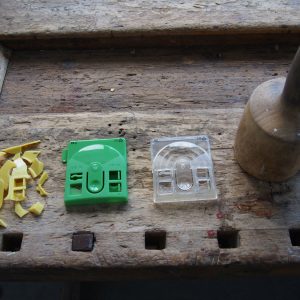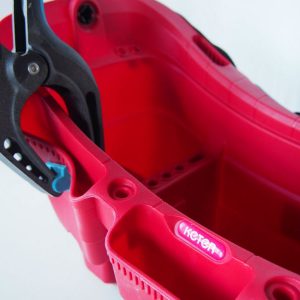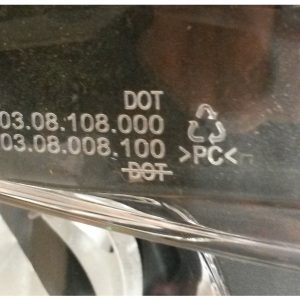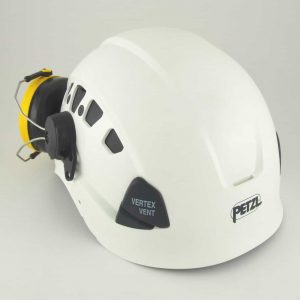When my wife dropped her old cell phone from the balcony to the concrete-paved yard, the phone took a few bounces and distributed itself then in several pieces around it. That was it, I thought. But as we collected the pieces, snapped them together and turned the power on, the phone worked perfectly again despite the few scratches it had gained. Excellent job on mechanical design, I had to conclude (the phone was, by the way, an ancient Nokia).
Impact resistance (or impact strength) describes a material’s or a product’s ability to absorb shock or impact energy without breaking.
Something that feels strong and stiff might be surprisingly easy to break with a bump to the right spot. Resistance against impacts is one of the key requirements in plastic product design. It is clear that a helmet or a ski boot should have high impact resistance, but almost every plastic product is subjected to impacts at some point of its service life and the consequences are often irreversible. All products should preferably be impact resistant to a degree for more reasons than one. They may fall down from store shelf before they ever meet the customer, to begin with.
Impact resistance is in fact one of the key strengths of plastics. It is why they are used in e.g. helmets, riot shields and sports gear. They replace glass in many applications, and in some cases they can be more durable than metals; if you kick a metal bucket, for example, you easily make a dent in it. A well designed plastic bucket would take the impact with no problem.
Impact resistance is not, however, an inherent material property to all plastics grades. Some grades are rather poor in withstanding impact, as we all may have noticed with cheap plastic toys or other similar products.
Selecting the right material is in main role when designing impact resistant products but the mechanical design/geometry makes a big difference as well. Tips on material selection and mechanics can read below.
Impact Resistance – tips for plastic material selection
Either I am dumb or the Izod and Charpy values expressed on the datasheets are confusing, but I have never been able to utilize them in practise. Apart from the units being sometimes in J/m and sometimes in J/m2, the tests are conducted in circumstances that are not particularly realistic in terms of load case, product geometry, material orientation and temperature. I understand that the general purpose of the data is to help designers to compare different plastic grades, but in case of impact resistance I haven’t found them useful. If you have been able to make use of them in practise, please tell us how in the comments at the bottom of this page. I have instead opted to divide the plastic materials into three groups:
1 Brittle materials that should be avoided when risk of impacts is high
These are for instance amorphous grades, such as PS, PSU, SAN and PMMA (although it is used on ice-skating rink panels). They all share a lack of overall toughness. Lack of toughness is also a factor that reduces the impact resistance of some reinforced plastics. PPS+40GF, for instance, has very high modulus and therefore low toughness. If you knock the edge of the corresponding Plasticprop sample, you can hear a glassy sound. This indicates low impact strength. The same applies for polypropylene. PP-H (homopolymer) is stronger and stiffer than PP-C (copolymer), but its toughness and therefore impact resistance is smaller.
2 Impact resistant materials
Polycarbonate PC is the mother of all impact resistant plastics. However, its superior properties are not fully explained by high toughness. The molecule structure of PC is very firm and it requires a lot of energy to tear the chains apart. The high impact resistance of polycarbonate is utilized in many alloys like PC/ABS, PC/PBT and PC/PA. Here is an amusing video that illustrates PC impact resistance over PMMA:
ABS is also known for its impact resistance which remains good also in low temperatures. This is based on the small butadiene particles that absorb the impact energy. The same principle applies also for HI-PS and impact modified PP (PP+TPE-O). PPO was earlier quite common choice for TV housing. It is often used as an example of good impact resistance, but my personal experience of the material is limited.
3 The materials in between the two
Practically all engineering plastics like PA, PBT and POM withstand impact relatively well. This again depends on toughness. If you can cause a permanent deformation in a material sample by bending it, this indicates that the material has a degree of plastic behaviour. If so, it is probably reasonably impact resistant.
Plastic product Impact resistance – what can you do with the geometry
- Skilled boxers have good impact resistance. They can absorb the energy of impacts with their whole body, not just one part of it, nose for instance. The same principle applies not only to material toughness, but to mechanics as well:
- Try to distribute the energy of impacts to the whole construction. Do not maximise the stiffness of the product without a good reason. Think of the component as a spring.
- Impact resistant materials are able to absorb energy in their internal structure. That requires bulkiness to some degree from the construction. A helmet with 0,5 mm wall thickness is not very impact resistant. Robustness is good. Don’t make the shock-absorbing elements too thin or lacy.
- Sharp corners and notches operate as stress raisers. This goes with static loads as well, but in the case of impacts, they are merciless.
- A rib that is meant to strengthen the product might easily reverse the intended purpose by crack propagation. Ribs should preferably be under compression rather than tension.
- If possible, try to avoid weld lines in the areas that are exposed to shocks. The same goes for gating, too.
Other aspects to take into consideration
Reinforcement
Reinforcements are two-edged swords when it comes to impact resistance. Increased strength is a benefit but high stiffness reduces toughness. Being able to decode the Charpy-V or Izod values might help, but I suggest studying each case with a hammer.
The effect of temperature
Service temperature is an important factor in impact resistance. In elevated temperatures it tends to be higher (to a limit), but when it is lowered, plastic products tend to turn stiffer. As the modulus of the material is increased, some toughness is lost. Amorphous plastics do this gradually but semi-crystalline materials might turn from ductile to brittle very suddenly as the temperature goes below their Tg. A water bucket made of PP (Tg app -10°C), for example, might easily break on a cold winter day while a HD-PE bucket (Tg app. -90°C) is still ductile. Based on this, one might expect PA6 (Tg app. 50°C), for instance, to be brittle in room temperature, but it is not. It is not that simple, in other words; each plastic material has its own characteristics.
Finding a stress-strain-temperature curve for each material candidate is therefore helpful and Campusplastics database is worth researching: Type for an example “stress-strain PC” into the search-area to find diagrams available for different PC grades.
Impact fatigue
Resistance against fatigue applies to impacts as well. Some plastic products might withstand single shocks well, but fail with repeated impact, even with smaller energy level. My practical experience is that amorphous materials are more sensitive to impact fatigue than semi-crystalline, as is the case with normal fatigue. Long term testing of impacts must not be overlooked.



